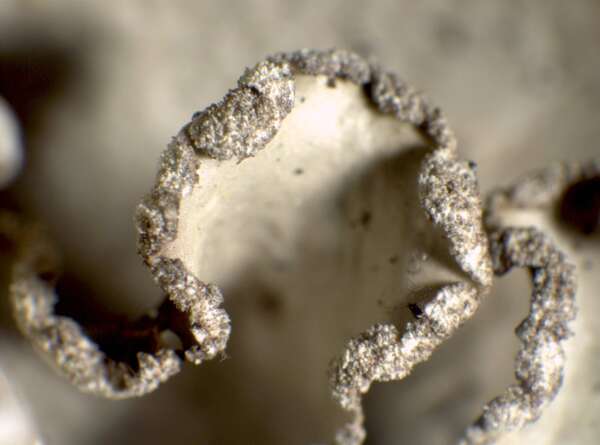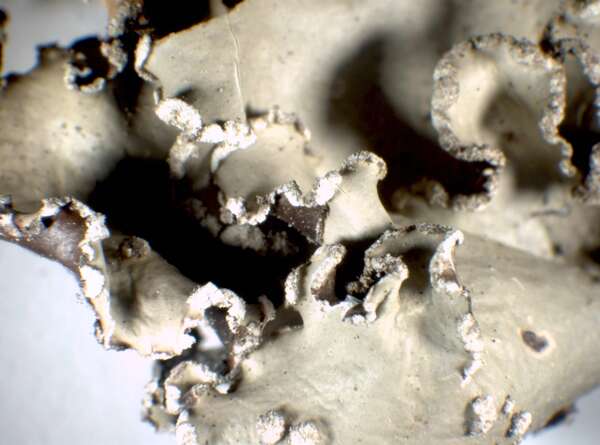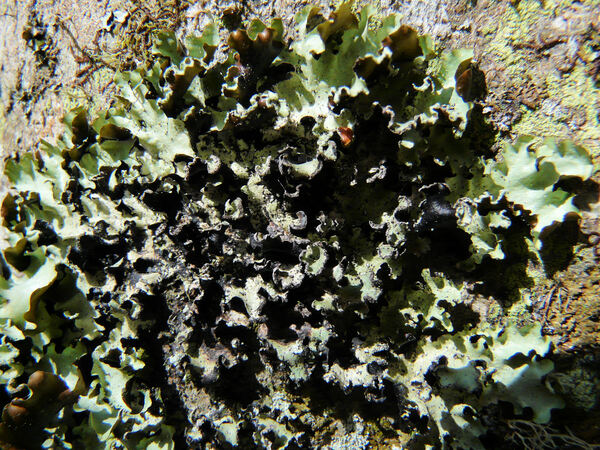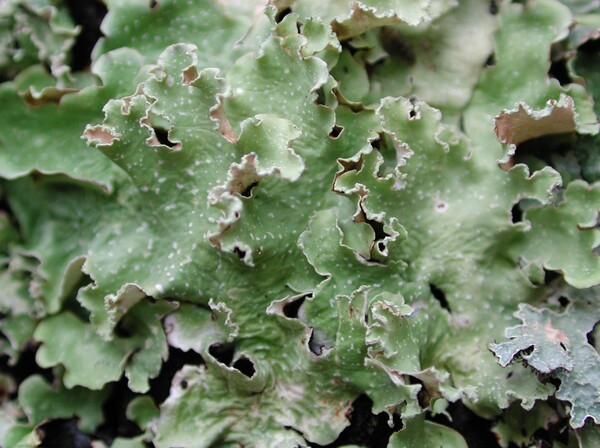Cetrelia olivetorum (Nyl.) W.L. Culb. & C.F. Culb.
Contr. U.S. Nat. Herb., 34: 515, 1968. Basionym: Parmelia olivetorum Nyl. - Not. Sällsk. Fauna Fl. Fenn. Förh., n. ser., 5: 180, 1866.
Synonyms: Parmelia cetrarioides var. rubescens (Th. Fr.) Du Rietz; Parmelia olivaria f. subvenosa Gyeln.; Parmelia rubescens (Th. Fr.) Vain.; Pseudoparmelia aradensis Gyeln.
Description: Thallus foliose, heteromerous, dorsiventral, broad-lobed, loosely attached, forming wide-spreading, usually orbicular 6-20(-40) cm wide rosettes. Lobes broad and rotund, (0.5-)1-1.5(-2) cm wide, with raised, wavy margins, greenish grey (sometimes tinged brown), with punctiform pseudocyphellae on upper surface, which are rather small and usually not raised, often concentrated in the submarginal parts of lobes; pseudocyphellae on the lower surface not developed, or appearing as very small white dots. Soralia primarily marginal, elongated, usually smooth, with fine to rather coarse soredia. Lower surface black, rather regularly ridged, with scattered, simple, black rhizines and a brown, rhizine-free zone along the margin. Upper and lower cortices prosoplectenchymatous, the upper one with a non-pored epicortex, of densely agglutinated hyphae with tiny lumina; medulla white, with isolichenan, I-. Apothecia very rare, lecanorine. Asci 8-spored, Lecanora-type. Ascospores 1-celled, hyaline, ellipsoid, 12-15 x 7-10 µm. Pycnidia unknown. Photobiont chlorococcoid. Spot tests: cortex K+ (weakly) yellow, C-, KC-, P-; medulla and soralia K+ yellow, C+ strongly blood-red, KC+ reddish, P-, UV-. Chemistry: cortex with atranorin and chloroatranorin (in lower amounts than in soralia); soralia (and medulla) with atranorin, olivetoric acid, anziaic acid, and 4-O-demethylmicrophyllinic acid, sometimes with a fatty acid.
Growth form: Foliose, broad lobed
Substrata: bark
Photobiont: green algae other than Trentepohlia
Reproductive strategy: mainly asexual, by soredia, or soredia-like structures (e.g. blastidia)
Most common in areas with a humid-warm climate (e.g. most of Tyrrenian Italy)
Commonnes-rarity: (info)
Alpine belt: absent
Subalpine belt: absent
Montane belt: very rare
Dry submediterranean belt: extremely rare
Humid submediterranean belt: extremely rare
Padanian area: absent
pH of the substrata:
1 2 3 4 5
Solar irradiation:
1 2 3 4 5
Aridity:
1 2 3 4 5
Eutrophication:
1 2 3 4 5
Poleotolerance:
0 1 2 3
Altitudinal distribution:
1 2 3 4 5 6
Rarity
absent
extremely rare
very rare
rare
rather rare
rather common
common
very common
extremely common
Loading data...
Occurrence data
Predictive map
 Current prediction (1981-2010)
Current prediction (1981-2010) Future prediction (2071-2100) SSP 1-2.6
Future prediction (2071-2100) SSP 1-2.6 Future prediction (2071-2100) SSP 5-8.5Predictive maps according to Francesconi et al. 2025
Future prediction (2071-2100) SSP 5-8.5Predictive maps according to Francesconi et al. 2025
P.L. Nimis; Owner: Department of Life Sciences, University of Trieste
Herbarium: TSB (29405)
2001/12/09
soralia

P.L. Nimis; Owner: Department of Life Sciences, University of Trieste
Herbarium: TSB (29405)
2001/12/09
Growth form: Foliose, broad lobed
Substrata: bark
Photobiont: green algae other than Trentepohlia
Reproductive strategy: mainly asexual, by soredia, or soredia-like structures (e.g. blastidia)
Most common in areas with a humid-warm climate (e.g. most of Tyrrenian Italy)
Commonnes-rarity: (info)
Alpine belt: absent
Subalpine belt: absent
Montane belt: very rare
Dry submediterranean belt: extremely rare
Humid submediterranean belt: extremely rare
Padanian area: absent
pH of the substrata:
| 1 | 2 | 3 | 4 | 5 |
Solar irradiation:
| 1 | 2 | 3 | 4 | 5 |
Aridity:
| 1 | 2 | 3 | 4 | 5 |
Eutrophication:
| 1 | 2 | 3 | 4 | 5 |
Poleotolerance:
| 0 | 1 | 2 | 3 |
Altitudinal distribution:
| 1 | 2 | 3 | 4 | 5 | 6 |
Rarity
absent
extremely rare
very rare
rare
rather rare
rather common
common
very common
extremely common
Loading data...
Occurrence data
Predictive map
 Current prediction (1981-2010)
Current prediction (1981-2010) Future prediction (2071-2100) SSP 1-2.6
Future prediction (2071-2100) SSP 1-2.6 Future prediction (2071-2100) SSP 5-8.5
Future prediction (2071-2100) SSP 5-8.5Predictive maps according to Francesconi et al. 2025

P.L. Nimis; Owner: Department of Life Sciences, University of Trieste
Herbarium: TSB (29405)
2001/12/09
soralia









